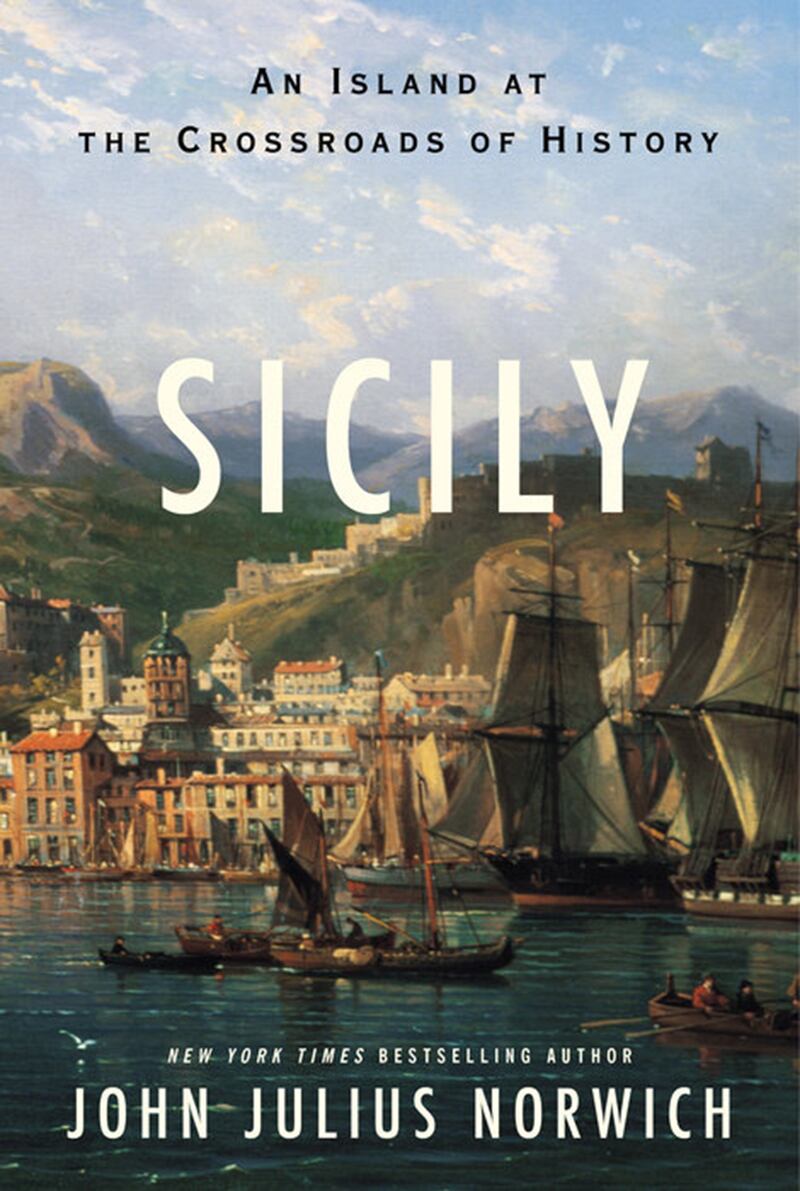Anybody who travels in areas frequented by British tourists (Tallinn, the Algarve, Tuscany) is no doubt familiar with the “Brits abroad” stereotype. For those who aren’t, it essentially boils down to British tourists who are loud, exceptionally drunk, sunburnt, and demanding.
There is, however, a different sort of Brit abroad, that of the ex-pat completely immersed in the culture, an excellent drinking companion, full of juicy stories, spouting politically incorrect but insightful views.
In his new book, Sicily: An Island at the Crossroads of History, diplomat-turned-historian John Julius Norwich is the latter. His book is written with passion about the art and architecture of this magical island, filled with gossipy tidbits and sweeping historical theories, not to mention biting criticisms of historical figures one can easily imagine spewing out in between puffs of cigarettes on the loggia of a villa after five or six martinis.
Sicily has sometimes been referred to as the most conquered island in the world, and that mixing throughout history is apparent when one wanders its cities, or from quirks of history like Walter of the Mill, who signed his papers “Emir and Archbishop.” Norwich’s tale certainly gives that impression, as the next two thousand years is pretty much a litany of conquerors taking control of the island.
Norwich’s tome begins tracing the island’s history during the Hellenistic era, during which time Sicily faced internal strife between its various city states, as well as intrigue and war from others, like Athens to the east, and Carthage to the south (which had a foothold on the island). From there it is largely controlled by Carthage until the Romans take it in the Punic Wars.
Under the Romans, Sicily is grossly mistreated, in Norwich’s view, but it becomes an important part of the empire as it one of the most important producers of grain. Otherwise, this period is largely quiet, minus a slave revolt here or there.
The 5th century brought the barbarians, and for Sicily, its scourge was the Vandals. Under Gaiseric, Sicily was raided and conquered, although it would later come under Theodoric (leader of the Goths) when he seized control of the entire peninsula.
In 533, Sicily was to again change hands, this time back to the Greeks under the Byzantine Empire, only to find itself part of the Muslim world in the 9th century, as city after city fell to the new conquerors. While Norwich notes the many benefits that often came with rule by Muslim powers in that age (technology, education, religious tolerance), internal strife was to remain an issue, which left the door open to yet another conqueror—the Normans.
Norwich is not a historian operating at a remove. He names names and does not flinch from making clear his preferences. The benefit of this is most clear in the section on the Normans.
Viking descendants ruling northwestern France and (later) southern England, the Normans came to Italy for two reasons, Norwich contends—pilgrimage and thrill-seeking. They were an incredibly fertile people, and had an abundance of young men looking for a way to make their mark.
“South Italy,” writes Norwich, “was a cauldron, never altogether off the boil. Surrounded and pervaded by the constant clashing of two empires, three religions—for the Muslims of Sicily were making constant inroads—and an ever-varying collection of independent, semi-independent or rebellious cities.” One family in particular stood ready to take advantage, the de Hauteville’s. Their patriarch, Tancred, is dismissed by Norwich as being “notable only for his determined and persistent fecundity.”
Over 31 years, beginning in 1060, the Normans conquered Sicily. By its finish, the Guiscard family ruled all of Sicily, along with the portion of southern Italy comprised by the Duchy of Apulia and Calabria.
The region’s first ruler was Roger I, brother of the leader of the Guiscard’s in Italy, Robert. It is under Roger that the seeds of a successful Norman rule are sowed. He allowed the mosques to stay open and Arabs to remain in certain posts, spent vast sums rebuilding the Greek churches, and worked to integrate those he brought with him. He fathered at least 13 children (but possibly 17) and married three times. He was succeeded by his son by his third wife, Roger II.
While Norwich is less enamored with his successors, he certainly seems ready to start a fanboy club for Roger II. Crowned king in 1130, Roger’s united Sicily and southern Italy gave him “the third largest kingdom in Europe.” According to Norwich, this kingdom “could no have had a better ruler” as Roger came from a Norman father and Italian mother, was educated by Greek and Arab tutors, and grown up in one of the most learned and diverse courts in Europe.
At the height of the Crusades, Roger ruled a polyglot kingdom of varying religions and ethnicities. His legacy is perhaps best reflected in architecture, which he managed to fuse brilliantly the best of Byzantine, Arab, and Norman design. His court in Palermo was “unparalleled in Europe.” He managed the factions, Norwich claims, by putting each group to their best use. The navy was always run by Greeks, for Greeks were “by far the best seamen” and the treasury was run by Arabs “whose mathematics were always better than anyone else’s.”

He tasked his close friend Abu Abdullah Mohammed al-Edrisi with putting together all the geographical knowledge accumulated at that point about the known world. Its result is “the greatest geographical work of the Middle Ages, The Advocation of a Man Desirous of a Full Knowledge of the Different Countries of the World, or, The Book of Roger. (The book famously claimed the earth “is round like a sphere”).
The Normans, much to Norwich’s disappointment, would not last. Their line would lose its hold when William II betrothed his daughter to the son of the Holy Roman Emperor Frederick Barbarossa. From then on, Sicily would become just another piece of another entity’s kingdom. It would pass from the Hohenstaufen’s to the Anjou’s to the Aragonese to the Hapsburgs and finally, before the Risorgimento, the Bourbons. Sicily would again take center stage in 1860, as Garibaldi’s launching point for his war to unite Italy. Throughout its post-Norman history, Sicily would be plagued by brigandage, piracy, and barons that acted like warlords. These were the roots, Norwich argues, for the mafia. The book ends with Sicily taking center stage yet again, as the Allied launching point for the invasion of Europe from Africa. American intelligence “colluded” with the mafia, and in the war’s aftermath, it completed its chokehold on the government of the island.
Norwich without a doubt could have a second career as the world’s greatest tour guide.
His footnotes—which I imagined as quippy asides in the voice of the narrator of Vh1’s The Fabulous Life—are filled with juicy tidbits.
Such as the marriages of Dionysus I of Syracuse, who Norwich notes are supposed to have been “consummated in a single night.” He then sneers, “The resultant daughters were named Prudence, Virtue and Justice—perhaps to compensate for a mother named Doris." When he writes about General Pyrrhus (of Pyrrhic victory fame) he seems to sigh and then declares, “One would love to know how and where Pyrrhus acquired [elephants] … They—and Hannibal’s after them—were presumably African; and African elephants, unlike the Indian variety, are always said to be impossible to train. Did Pyrrhus and Hannibal know something we don’t?”
There is no sanitizing history in this book. The death of King Roger, despite being idolized in the book, is told to have come from “exhaustion from his immense labors, and the onset of a premature senility through his addiction to the pleasures of the flesh, which he pursued to a point beyond that which physical health requires.”
His judgments are poetically sweeping. William II, while good-looking (Norwich is very thorough in making sure we know who was attractive and who was not) unfortunately had “three blessings … withheld from him: first, a long life; second, a son and heir; third, a modicum of political wisdom. Had he been granted any of these, his kingdom might have been spared … As he lacked all three, Sicily was doomed.”
When Sicily comes under Aragonese rule, Norwich shares the tale of King Martin, who died “of uncontrollable laughter at a joke by his jester, having just eaten a whole goose” and as he had no heirs, his line died out.
He wonders aloud at why Pope John XXIII would choose the same name as an antipope who was “only accused of piracy, murder, rape, sodomy, and incest.”
Wedding nights take a prominent place in the book’s chronicles. Some are even funny, such as that of Ferdinand and Maria Carolina in Naples. Norwich tells us that the morning after, the king told his entourage, “She sleeps as if she had been murdered and sweats like a pig.” This, by the way, is the same Ferdinand to whom Norwich ascribes a glove fetish. He quotes a member of the Neapolitan court, who claims, “[Ferdinand’s] brain becomes exalted when he sees a glove well stretched over a beautifully shaped arm … How many affairs of the greatest importance have I seen settled by the Queen’s care to pull her gloves over her pretty arms.”
Norwich also is passionate about art and architecture, and devotes worthy time to Sicily’s gems (the Palatine Chapel, Monreale, Giacomo Serpotta) that often go unnoticed when Italy is discussed.
And there is plenty of violence. An emperor is killed with a soap dish by a servant while he bathes. One barbarian king murders another “with one tremendous stroke of his sword” and slicing through his rival’s body “from collarbone to thigh.” One king of Sicily roasted his opponents alive, and even was accused of crowing a rival with a “red-hot crown, which was then nailed into place.” Another claimant to the throne, a boy, is “blinded and castrated in a German prison.”
For a 350-page book teeming with names largely unfamiliar to the casual reader, it is utterly engrossing. Norwich has managed to craft a book that is approachable (a rare find these days), fun, and brimming with information. Don’t be surprised if, after finishing the book, you start looking at flights.






